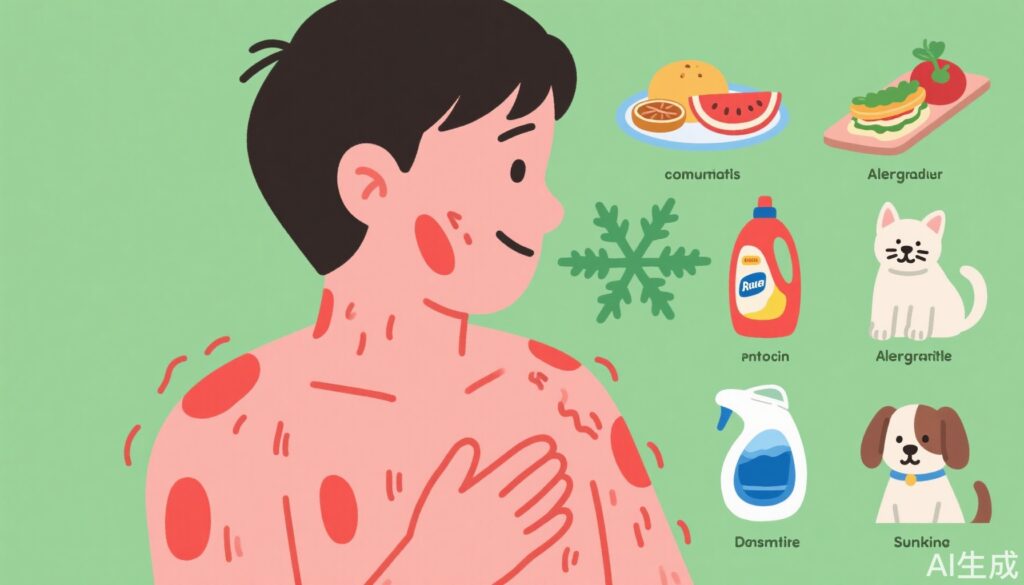Introduction to Urticaria
Urticaria, commonly known as hives, is a widespread skin condition characterized by sudden outbreaks of red, itchy welts or patches on the skin. These symptoms can cause significant discomfort, including intense itching and redness. Understanding how urticaria develops and what common daily exposures can trigger it is essential for effective prevention and management. This article delves into the various causes and common triggers to help readers better protect their skin health.
Recognizing Urticaria
Have you ever experienced sudden large red rashes accompanied by unbearable itching? This is often urticaria at work. The causes of urticaria are complex and varied, and many seemingly harmless daily contacts can trigger an outbreak. Let’s explore how urticaria is contracted and which everyday exposures most commonly provoke it.
Causes of Urticaria
Food Factors
Food is one of the most common causes of urticaria. High-protein foods such as fish, shrimp, crab, and shellfish frequently trigger allergic reactions that lead to hives. Additionally, milk and eggs can act as allergens for some individuals. Certain fruits like strawberries, mangoes, and peaches contain histamine or other compounds that may cause allergic symptoms. Food additives, including artificial coloring, preservatives, and fragrances, are also potential triggers.
Medication Factors
Many medications can induce urticaria. Antibiotics such as penicillin and cephalosporins are well-known allergens. Common pain relievers and fever reducers like aspirin and ibuprofen may also cause allergic reactions. Furthermore, serum products and vaccines can sometimes provoke hives. Drug-induced urticaria typically appears within hours to days after taking the medication and can present with severe symptoms.
Infectious Factors
Various infections may lead to urticaria. Bacterial infections such as those caused by Staphylococcus aureus or Streptococcus species can result in conditions like tonsillitis, pharyngitis, or sinusitis that trigger hives. Viral infections including influenza, hepatitis viruses, or Coxsackie virus can also be culprits. Fungal infections, such as skin ringworm, and parasitic infestations like roundworms or hookworms may provoke urticaria as well. In infection-related cases, accompanying systemic symptoms like fever and fatigue are common.
Physical Factors
Physical stimuli can induce urticaria in sensitive individuals. Exposure to cold, heat, sunlight, friction, or pressure can cause skin reactions. Cold urticaria manifests as wheals or swelling on areas exposed to cold wind, water, or objects. Heat urticaria appears within minutes after heat exposure. Solar urticaria develops within minutes to hours following sun exposure. Friction or pressure on the skin can lead to linear wheals known as dermatographism.
Psychological Factors
Emotional stress, anxiety, and depression can influence the immune system and trigger urticaria. Prolonged psychological stress disrupts hormonal balance and increases susceptibility to allergic responses. Some patients notice worsening or recurrence of hives during periods of emotional upheaval.
Genetic Factors
Certain forms of urticaria may have a hereditary component. If family members have a history of hives, the likelihood of others developing the condition increases. Genetic predisposition affects immune system responsiveness to specific allergens.
Common Daily Items That Trigger Urticaria
Cosmetics
Ingredients in cosmetics such as fragrances, preservatives, and colorants can provoke skin allergies. Inferior products may contain heavy metals like lead or mercury, which are particularly irritating. If symptoms such as itching, redness, or bumps occur after cosmetic use, discontinue immediately.
Detergents
Detergents including laundry powders, dishwashing liquids, and fabric softeners contain chemicals like surfactants and preservatives. Prolonged contact, especially with the hands, may cause dryness, itching, redness, or even urticaria. Wearing gloves during cleaning tasks is advisable.
Pet Hair and Dander
Pets shed hair and skin flakes that harbor allergens capable of triggering urticaria. Close contact can transfer these allergens onto skin and clothing, provoking allergic reactions. Individuals with allergies should limit close interactions with pets.
Pollen
During pollen seasons, airborne pollen particles are abundant. Inhalation or skin exposure to pollen can cause allergic responses leading to hives. Spring and autumn typically see higher pollen concentrations; wearing masks and limiting outdoor activities can help reduce risk.
Dust Mites
Dust mites are common indoor allergens found in dust, bedding, sofas, and carpets. Their feces and body parts are major sensitizers. Maintaining clean living spaces, washing bedding regularly, changing sheets often, and using air purifiers can minimize dust mite exposure.
Prevention and Management
Understanding the diverse triggers of urticaria is crucial for effective prevention. Avoiding known allergens, using hypoallergenic products, and protecting the skin from physical stimuli can reduce incidents. Managing psychological stress through relaxation techniques may also help. When urticaria occurs, consulting a healthcare professional promptly is important to receive appropriate treatment, which may include antihistamines or other medications.
Conclusion
Urticaria arises from a combination of food, drug, infectious, physical, psychological, and genetic factors. Everyday items like cosmetics, detergents, pet dander, pollen, and dust mites can also spark outbreaks. Awareness of these causes enables individuals to take proactive steps in daily life to prevent hives and maintain skin health. In case of symptoms, timely medical consultation is essential. This article provides general information and does not replace professional medical advice; please seek in-person care if symptoms persist or worsen.


